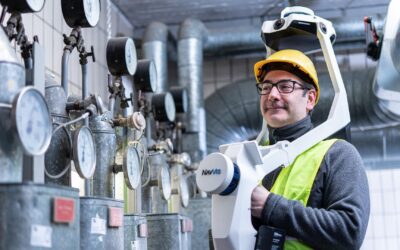The benefits of simulation in machine building are by now well reported. But despite the countless articles and stories on the subject, it’s still a technology that isn’t well understood, and by extension, adopted. In fact, I estimate that just 10% of the UK machine building community are using simulation technology in their machine design and development. Adoption rates are much higher across Europe where machine builders are using this to their own competitive advantage.
Which really begs the question: Why? If the use case is so clear cut, why are we stalling?
For me, there are three key hurdles to adoption: limited understanding; fear of cost; and lack of internal skills. In this article, I’ll explore how these three factors are acting as a barrier to change, and what we can do to ease the road to adoption.
What is simulation in machine building and what is the business case for change?
Typically, machine building is done in phases – the software is often developed after the mechanical and electrical designs are completed. It’s often the software time that is limited on a machine with the deadline approaching.
By comparison, in a simulated environment, this process can be done in parallel. You can digitally design machines, simulate faults and collisions, and test code before it’s deployed onto the physical machine.
This saves significant time as you aren’t reliant on physical hardware for testing, and importantly, it reduces the margin of risk in the build – having tested all eventualities virtually, you can be more confident of its performance physically.
Simulation technology is also great for building a seamless digital workflow thanks to a shortened deployment time. With fully integrated physical and digital technology, everything happens simultaneously and in a shared environment. This means that changes and fixes can happen quickly and with minimal disruption – something that shouldn’t be taken lightly in today’s fast-paced world. This approach also ensures one source of the trust, all changes are tracked and understood. Reducing the multitude of separate documents and changes.
If all of the above is the value, why is the estimated adoption rate so low?
Simulation is still not well understood
Sometimes we can become so bogged down in the jargon and the hypothetical use cases for advanced technology, that we become overwhelmed. It feels easier to carry on with tried-and-tested processes than to embrace change and potential disruption. And so, things never change – but the conversation continues.
Even though it’s important that we spend time getting confident on simulation, you don’t have to be an expert to get started.
Rather than getting wrapped up in technicality, I recommend starting with your business needs, and then researching how solutions like simulation could help you fix that challenge. Look for case studies with similar organisations and seek out results, rather than trying to learn it all. It’s also worth contacting industry experts, or networking at events to get a feel for how simulation can help you.
Simulation is an investment
Many companies succeed in getting buy-in for the project, but stumble at the final hurdle – paying for it. The upfront investment of digitalisation can be daunting, especially in companies with legacy systems that have been part of the fabric of the organisation for years.
In this situation, I have two recommendations. Firstly, explore your financing options. There are countless ways to upgrade, scale and digitalise without investing up-front. One example is Siemens Xcelerator. We are all used to subscription-based software in our home life. Xcelerator enables machine builders to access a wide range of simulation software on a subscription basis. This option moves the cost from Capital Expenditure (CapEx)to Operational Expenditure (OpEx). Reducing the initial financial outlay, whilst ensuring that software is always up to date with the latest version.
Alternatively Siemens offers token-based licensing, this enables greater agility at a lower cost when working with simulations. For example, the ability to purchase tokens that span across a range of software to focus on tackling the task at hand reduces CapEx while providing engineering teams with the flexibility to simulate a range of specific hierarchical components. This could involve anything from a simple line validation for ‘what if’ scenarios based on throughput or ramp-up, or the optimisation of complex processes through multiphysics simulations to enhance automated control. This agility enables greater value to be derived from the same investment.
Secondly, engage with Siemens to understand the on ROI. While digitalisation can feel expensive, it’s nothing compared to the cost of being inefficient or uncompetitive in a fast-paced market. To get spend over the line, it’s important to have a clear idea of what the tangible benefits will be long-term. In addition, the benefits of simulation are being more widely recognised by end users. A growing number of specifications are starting to request an element of simulation as part of the Invitation To Tender (ITT).
Internal expertise can be limited
Just like with any new technology, there aren’t a lot of people around that are both experts in simulation and experienced OEMs. This can make adoption difficult, as when internal stakeholders don’t have confidence in internal knowledge of simulation technology and its application, they are rarely going to champion it.
Luckily, when it comes to implementing this technology, you don’t have to go it alone. Specialist simulation partners will work with machine builders to introduce the technology to your set-up and will often work hand-in-hand with your team to design and deliver a solution that works. Some will even offer to provide training and support to develop your internal people into simulation experts.
Simply put, you don’t need to be an expert – you just need to be committed to change.
Conclusion
Simulation should now be a key part of every machine builder’s arsenal, but for many, this still isn’t the case. Whether it’s fear of the unknown, cost concerns, or just a lack of confidence, adoption is slower in the UK than it should be – especially considering the clear, proven benefits of this tech. In this article I’ve tried to show that whatever your concern, help is always on-hand to make the path to digitalisation simpler. I hope that by working together to create clarity, we can all move forward as an industry. It is my belief that adoption of software tools to enable simulation will help UK machine builders to become more competitive by enabling machines to be designed, commissioned, and deployed to the market faster.
Sign up today for a free Essential Membership to Automation Alley to keep your finger on the pulse of digital transformation in Michigan and beyond.
Siemens is a technology company focused on industry, infrastructure, transport, and healthcare. From more resource-efficient factories, resilient supply chains, and smarter buildings and grids, to cleaner and more comfortable transportation as well as advanced healthcare, the company creates technology with purpose adding real value for customers. By combining the real and the digital worlds, Siemens empowers its customers to transform their industries and markets, helping them to transform the everyday for billions of people.




